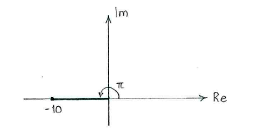Solution 3.2:5a
From Förberedande kurs i matematik 2
(Difference between revisions)
(Ny sida: {{NAVCONTENT_START}} <center> Bild:3_2_5a.gif </center> {{NAVCONTENT_STOP}}) |
m |
||
| (4 intermediate revisions not shown.) | |||
| Line 1: | Line 1: | ||
| - | + | The argument of a complex number is the angle of the line between the origin and the number measured with respect the positive real number axis. | |
| - | < | + | |
| - | + | In this case, we see directly that <math>-10</math> has the argument <math>\pi</math>. | |
| + | |||
| + | [[Image:3_2_5_a.gif|center]] | ||
| + | |||
| + | |||
| + | Note: All angles that correspond to the same direction differ by a whole number of turns, i.e. a multiple of <math>2\pi</math>, and therefore we could have just as well answered <math>-\pi</math>, <math>3\pi</math>, <math>5\pi</math> etc. However, it is usual to give the argument between <math>0</math> and <math>2\pi</math> or between <math>-\pi</math> and <math>\pi</math>. | ||
Current revision
The argument of a complex number is the angle of the line between the origin and the number measured with respect the positive real number axis.
In this case, we see directly that \displaystyle -10 has the argument \displaystyle \pi.
Note: All angles that correspond to the same direction differ by a whole number of turns, i.e. a multiple of \displaystyle 2\pi, and therefore we could have just as well answered \displaystyle -\pi, \displaystyle 3\pi, \displaystyle 5\pi etc. However, it is usual to give the argument between \displaystyle 0 and \displaystyle 2\pi or between \displaystyle -\pi and \displaystyle \pi.

